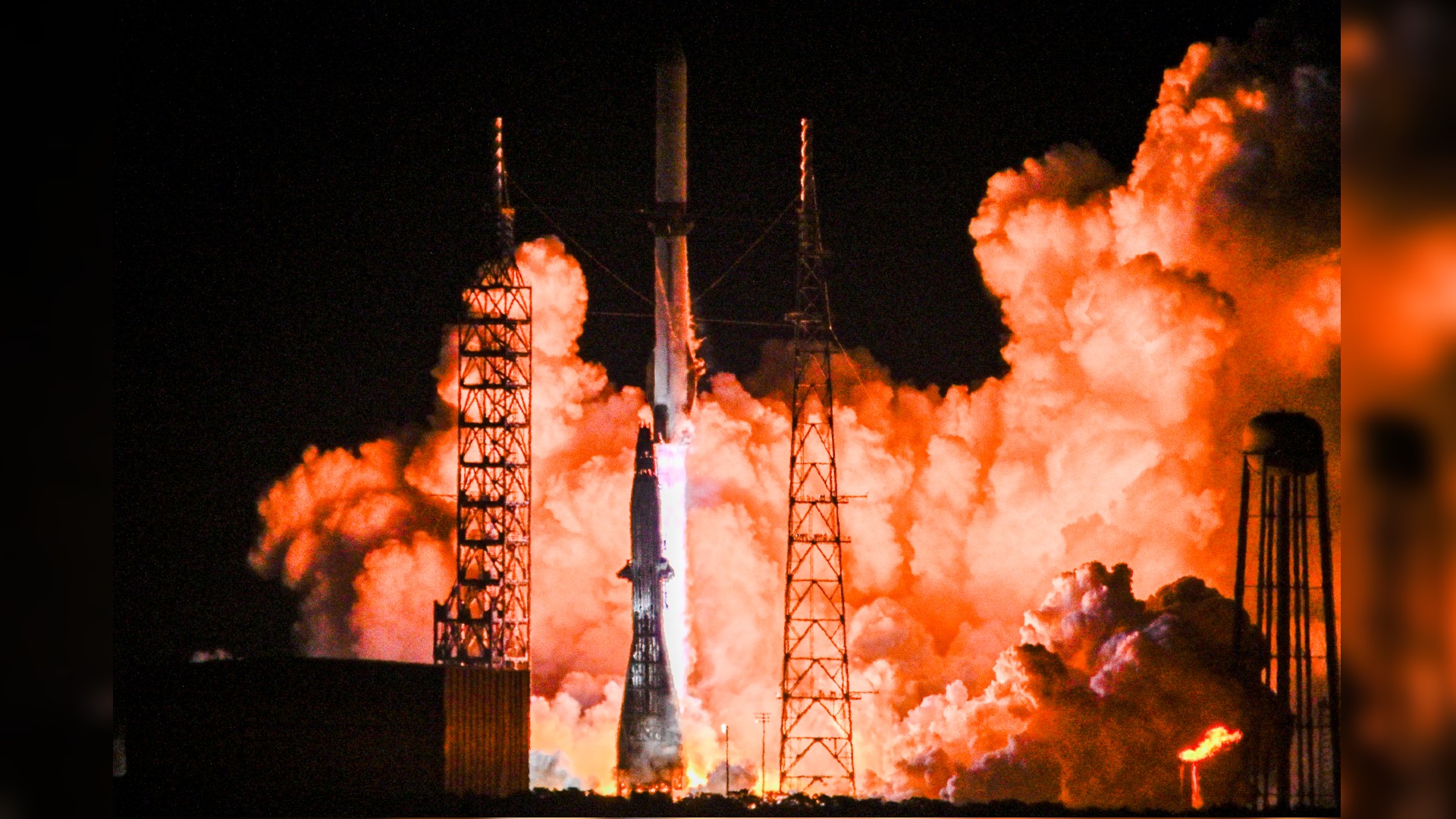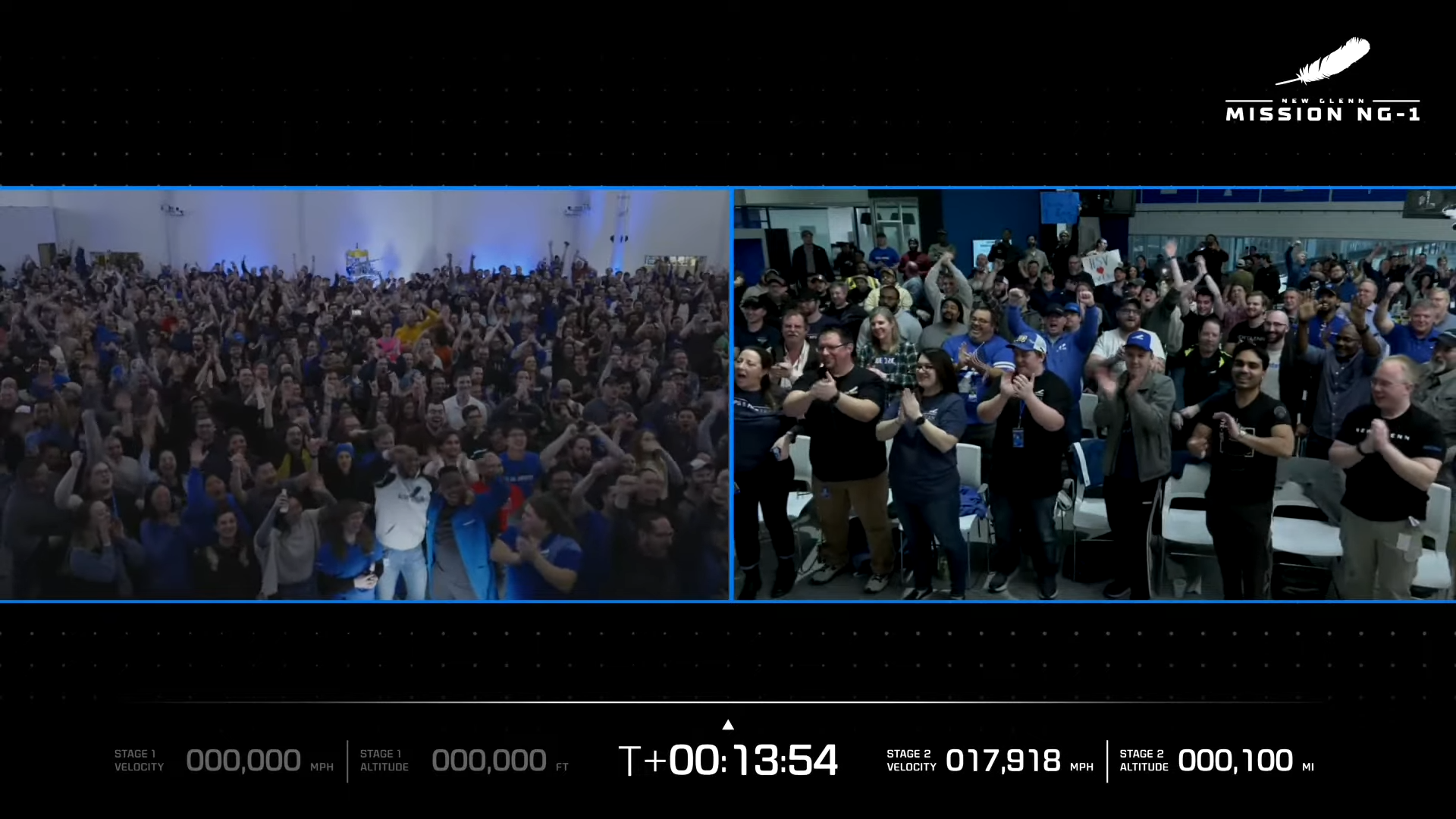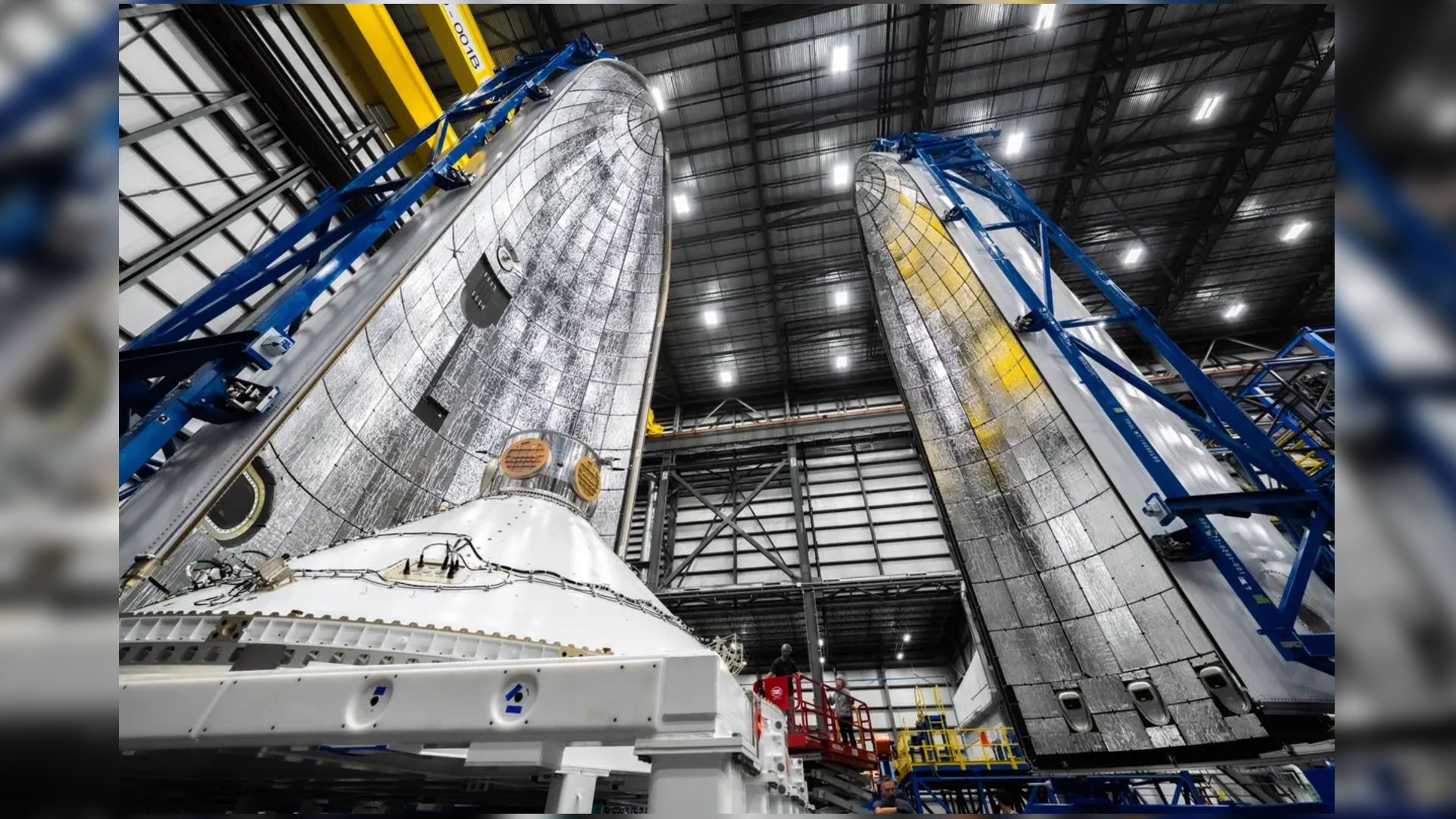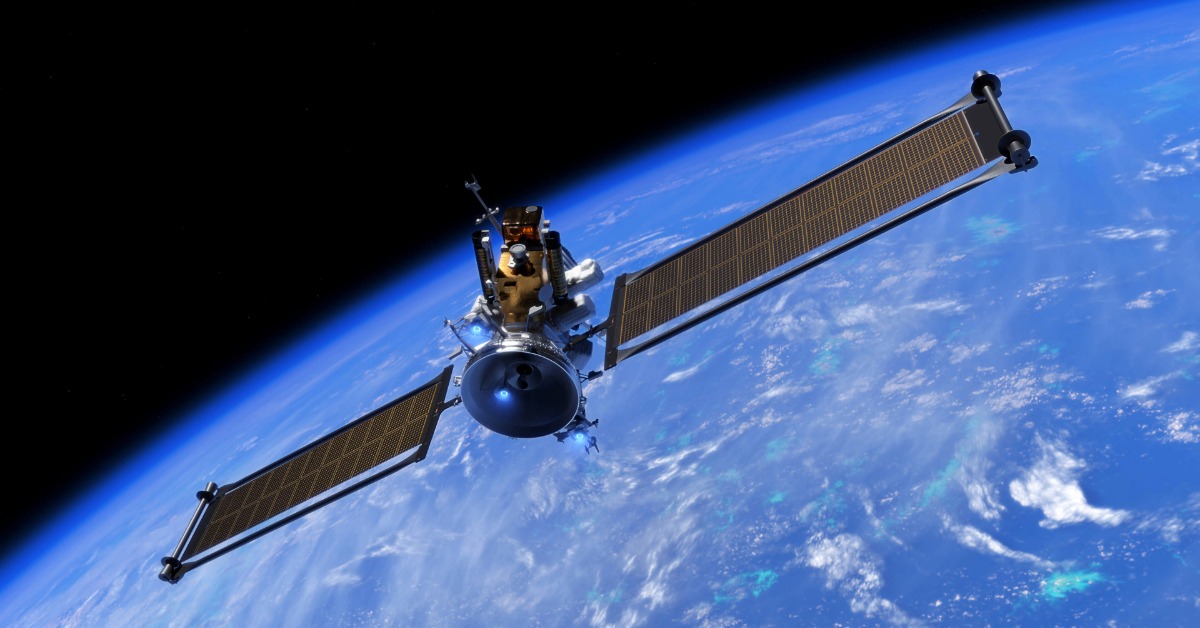Jeff Bezos' Blue Origin launches massive New Glenn rocket into orbit on 1st flight (video)
New Glenn just earned its wings.
COCOA BEACH, Florida — Blue Origin's New Glenn rocket just earned its wings.
New Glenn launched for the first time ever this morning (Jan. 16), rising off a pad at Cape Canaveral Space Force Station here on Florida's Space Coast at 2:03 a.m. EST (0703 GMT). About 12.5 minutes later, the rocket's upper stage reached orbit — the main goal of today's test flight, which the company called NG-1.
"We got to orbit safely,” Ariane Cornell, vice president of in-space systems at Blue Origin, said in the company's launch webcast. "Congratulations, everybody. What a day!"

Blue Origin also tried to land New Glenn's reusable first stage on a ship in the Atlantic Ocean, which is nicknamed Jacklyn, after company founder Jeff Bezos' mother. The booster managed to fire up three of its engines in a reentry burn as planned, but it didn't stick the landing.
"We didn't have booster landing, but man, we got close," Cornell said. "We collected so much data."
A successful landing would have been something of a surprise; the company had stressed repeatedly in the leadup to launch that this was a secondary goal that was unlikely to be achieved on NG-1.
Related: Blue Origin: Everything you need to know about the private spaceflight company
Breaking space news, the latest updates on rocket launches, skywatching events and more!
Like many rockets, the 320-foot-tall (98 meters) New Glenn took a long road to the launch pad. Its first flight was initially projected to take place in 2020, but development of the rocket's powerful BE-4 first-stage engines slowed the timeline.
There were a few more delays in the home stretch. Today's liftoff was originally planned for Jan. 10, but Blue Origin pushed things back 72 hours due to rough seas in the projected landing area for the booster. A launch attempt on Jan. 13 was scrubbed due to ice buildup in one of the rocket's power units, and Blue Origin then pushed the next try back to this morning.

New Glenn's reusable first stage could help it compete with SpaceX's venerable Falcon 9, the world's first orbital-class reusable rocket. Blue Origin aims to launch each New Glenn booster at least 25 times and already has customers ranging from NASA, various U.S. government agencies, AST SpaceMobile and other telecommunications companies.
New Glenn has also been tapped to help launch Amazon's Project Kuiper broadband internet satellites, which could become a competitor to SpaceX's Starlink megaconstellation. Amazon already has a license to launch over 3,000 Kuiper satellites.
Both Blue Origin and Amazon were founded by Bezos, who has flown to suborbital space aboard the company's smaller New Shepard space tourism rocket.
New Glenn is capable of carrying 50 tons (45 metric tons) of payload to low Earth orbit (LEO). SpaceX's Falcon Heavy rocket, which also features reusable first stage boosters, can lift around 70 tons (64 metric tons) to LEO.
If all goes to plan, NG-1 will help certify the rocket for the U.S. Space Force's National Security Space Launch (NSSL) program, which pairs U.S. military and intelligence spacecraft with commercial launch providers. NSSL launches also include GPS, communications and weather satellites that provide data and services to the U.S. government.
New Glenn was initially scheduled to launch NASA's twin ESCAPADE Mars probes on NG-1, but the space agency decided to delay the mission until the rocket proved itself worthy of flight. ESCAPADE is now scheduled to launch no earlier than Spring 2025.
Flying aboard New Glenn's first mission instead was a test version of Blue Origin's upcoming "Blue Ring" spacecraft.

This "Blue Ring Pathfinder" demonstrator is designed to validate Blue Ring's communications, in-space data collection, tracking and command systems while still attached to New Glenn's second stage, Blue Origin wrote in a an NG-1 mission description in December 2024. Such data collection will last for about six hours on NG-1, if all goes to plan.
This debut flight will help Blue Origin refine and develop the production version of the spacecraft for future missions. Blue Ring is being developed as part of the Defense Innovation Unit's (DIU) Orbital Logistics Program. DIU is a U.S. Department of Defense organization that aims to develop and field emerging technologies for national security.

To that end, Blue Origin is developing Blue Ring to fulfill DIU's need for a "heavy utility multi-orbit logistics vehicle," or m-OLV. Blue Ring, or whatever vehicle is eventually chosen to fill that role, will be designed to provide "low-cost, responsive access to geostationary (GEO) and other exotic orbits beyond low Earth orbit," according to a DIU statement.
In other words, Blue Ring will function as a platform for other satellites. It will be capable of carrying about 6,600 pounds (3,000 kilograms) across 13 different payload adapters.
The spacecraft will be able to transport payloads to geostationary orbit, cislunar orbit (orbits close to and around the moon) and even interplanetary orbits, according to a Blue Origin description.
That's all future work, however. The immediate take-home message from today's flight is that a powerful new orbital-class rocket has proved itself in flight.
"The next era of spaceflight at Blue Origin is upon us," Cornell said to close out the NG-1 launch webcast. "We look forward to seeing you soon on our next launch. We're just getting started."
Join our Space Forums to keep talking space on the latest missions, night sky and more! And if you have a news tip, correction or comment, let us know at: community@space.com.

Brett is curious about emerging aerospace technologies, alternative launch concepts, military space developments and uncrewed aircraft systems. Brett's work has appeared on Scientific American, The War Zone, Popular Science, the History Channel, Science Discovery and more. Brett has English degrees from Clemson University and the University of North Carolina at Charlotte. In his free time, Brett enjoys skywatching throughout the dark skies of the Appalachian mountains.
-
Philly Congrats Blue for reaching orbit.Reply
Can't wait to see where Blue is in 12 months and Jan of 26. That will say a lot about them. Is Blue still just Jeff's side hobby or will they be a real aerospace company/player? It will be interesting to see if they deliver actual results. Not so interested in the PR spin. I just have a feeling landing the 1st stage is going to be a lot of trial and error.
It was an interesting launch, it seemed to rise up very slowly from the launch pad, maybe it was the night launch and black background that made it look like it was taking a while to get going. Hopefully the next launch will be during the day. -
Unclear Engineer I watched the video, which was impressive, up the point of booster reignition for the landing sequence. At that point, the video of the booster engines froze, and its altitude and velocity data froze, along with the event time line slowly scrolling along the bottom of the screen. I get the impression that the data link with the booster may have been completely lost.Reply
i was disappointed that there was no video of the booster landing attempt. "We didn't have booster landing, but man, we got close," just raises the question about how "close". Did the booster come down on the ship, or miss it? If it came down on the ship, did it fall over? Did it do any damage? Was it even base end first? If it landed in the water, was it at least properly oriented and at zero velocity at the water's surface? Even if the data stream from the booster was stopped, what about video taken from the landing ship?
Anyway, good to see this much success in the first launch.
Before its first successful Falcon 9 landing, SpaceX had tried to land first stages twice on an uncrewed "drone ship" — once in January 2015, and then again in April. In those failures, the booster stage hit its target but came in a little too hard and crashed on the ship's deck. Blue Origin had first successfully landed its suborbital "New Sheppard" rocket about the same time. But landing something bigger like New Glenn is not as easy. -
sceh Reply
Did it really? There is something curious abut this launch.Admin said:Blue Origin's powerful New Glenn rocket reached orbit on its first-ever flight early this morning (Jan. 16).
Jeff Bezos' Blue Origin launches massive New Glenn rocket into orbit on 1st flight (video) : Read more
They very carefully state that it reached orbital speed but after that they waited 47 minutes before the second firing to take it to a ridiculously high orbit.
How many orbits did it do when it reached orbital speed? None or half one since an orbit takes around 90 minutes. Is this why they don't mention the number of orbits?
If the second burn comes from a restart of an engine and this is such a momentous event, how come there is no video and they never mention this momentous event?
Did it actually reach the higher orbit? If so, why no video and no mention and no mention of how many it did and no mention of what happened next? They did say that they didn't know where it was and couldn't say where it would land. Perhaps it is till there? Why would they not know where it is?
There are too many unanswered questions and lots of evasion from BO. I reckon it got to orbital speed and then ditched and never actually orbited except for the half orbit at LEO.
It is in their interest to tout a success and keep any incriminating details quiet.
